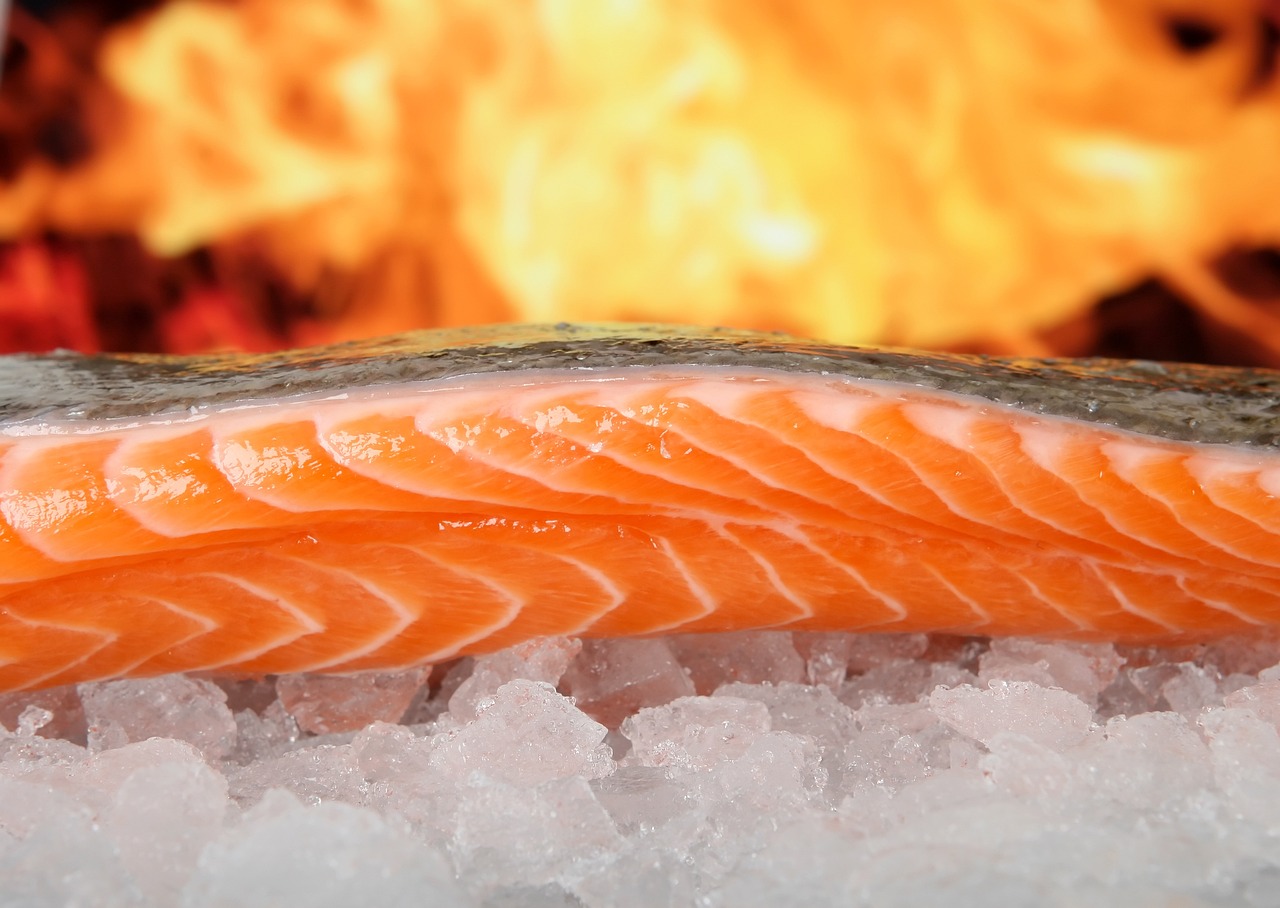
Unlock the secrets of preparing a perfect salmon dish with this comprehensive guide on “how to cook frozen salmon.” Whether you’re a seasoned chef or a novice in the kitchen, understanding the nuances of cooking frozen salmon is essential for preserving its nutritional value and achieving delightful flavors.
This article delves into the science of thawing, various cooking techniques, safety considerations, and top-notch recipes to elevate your culinary experience. If you’re intrigued by the prospect of a succulent and well-seasoned salmon dish straight from the freezer to your plate, this guide is tailored for you. Learn the art of cooking frozen salmon and discover why it’s a game-changer in the kitchen.
Key Takeaways
- Cooking salmon from frozen is a viable and flavorful alternative to traditional thawing methods.
- Thawing salmon may lead to nutrient loss, making cooking from frozen a preferred option for nutrient retention.
- Various cooking techniques include baking, pan-searing, grilling, and using an air fryer or Instant Pot.
- Seasoning frozen salmon before cooking enhances its flavor, with options like lemon, garlic, herbs, and spices.
- To prevent dryness, consider adding olive oil or butter before cooking and basting with natural juices during the process.
- Monitoring the internal temperature with a food thermometer ensures both safety and optimal texture.
- Three must-try recipes include Baked Lemon Garlic Salmon, Teriyaki Glazed Salmon, and Pesto Parmesan Crusted Salmon.
Understanding Salmon
Salmon is a nutrient-dense fish that contains essential omega-3 fatty acids, proteins, and vitamins. To preserve these nutritional elements during cooking, it’s crucial to comprehend the composition of salmon. The fish consists of muscle fibers, connective tissues, and water. When salmon is frozen, ice crystals form within these structures, causing potential moisture loss upon thawing and cooking.
The Science of Thawing
Traditionally, thawing has been recommended before cooking frozen salmon to prevent moisture loss and ensure even cooking. However, recent studies suggest that cooking salmon from frozen can be a viable and flavorful alternative. Thawing salmon can lead to the leaching of valuable nutrients into the water released during the process. Cooking frozen salmon directly helps retain these nutrients within the fish.
How to Cook Frozen Salmon?
Cooking frozen salmon directly is not only possible but also convenient. It eliminates the need for thawing, saving time while preserving the fish’s texture and flavor. To cook frozen salmon, follow these steps:
- Preheat your oven or pan to a moderate temperature (375°F or 190°C).
- Season the frozen salmon fillets with salt, pepper, and your choice of herbs or spices.
- Place the frozen salmon on a baking sheet or in a preheated pan.
- Cook for approximately 25-30 minutes in the oven or 10-15 minutes in a pan, flipping halfway through.
How to Cook Frozen Salmon without Thawing?
-
- Preheat the oven to 425°F (218°C) for optimal results.
- Season frozen salmon fillets with preferred herbs and spices.
- Place fillets on a parchment-lined baking sheet.
- Bake for 25-30 minutes, flipping halfway through for even cooking.
- This method guarantees a succulent and well-seasoned outcome.
How to Cook Frozen Salmon in a Pan?
-
- Heat a skillet over medium-high heat with a touch of oil.
- Place frozen salmon fillets skin-side down.
- Cook for 6-8 minutes on each side for a golden-brown crust.
- High heat sears in juices, resulting in a moist and flavorful dish.
- Season to taste and serve immediately for a quick and delicious meal.
How to Cook Frozen Salmon in the Oven?
-
- Preheat the oven to 375°F (190°C).
- Place frozen fillets on a baking sheet.
- Drizzle with olive oil and season with preferred spices.
- Bake for 30-35 minutes, ensuring even cooking.
- The oven’s consistent heat produces a perfectly cooked, juicy salmon.
How to Cook Frozen Salmon in an Air Fryer?
-
- Preheat the air fryer to 375°F (190°C).
- Place seasoned frozen fillets in the basket.
- Cook for 12-15 minutes, flipping halfway through.
- The air fryer’s circulating hot air results in a crispy exterior while maintaining tenderness inside.
- Enjoy the delightful texture contrast with minimal effort.
How to Cook Frozen Salmon on a Grill?
-
- Preheat the grill to medium-high heat.
- Brush grates with oil to prevent sticking.
- Place frozen salmon fillets skin-side down on the grill.
- Cook for 5-7 minutes per side for a smoky flavor and appealing grill marks.
- The grill adds a unique taste for those who love a barbecue touch.
How to Cook Frozen Salmon in an Instant Pot?
-
- Place a trivet in the Instant Pot and add water.
- Position frozen salmon fillets on the trivet.
- Seal the Instant Pot, set to Manual mode, and cook for 4-6 minutes on high pressure.
- Quick-release pressure for a speedy and convenient salmon dish.
- The Instant Pot retains the fish’s natural flavors and tenderness.
How to Bake Frozen Salmon?
-
- Preheat the oven to 400°F (204°C).
- Place frozen fillets on a parchment-lined baking sheet.
- Bake for 20-25 minutes to preserve natural flavors and moisture.
- This versatile method suits various occasions and provides a simple yet delicious dish.
Tips for Cooking Frozen Salmon
- Safety Considerations:
- Contrary to popular belief, cooking frozen salmon is safe as long as it’s done properly. Freezing helps preserve the freshness and nutritional content of the fish.
- According to the United States Department of Agriculture (USDA), it’s important to cook fish to an internal temperature of 145°F (63°C) to ensure it is safe to eat.
- Understanding Frozen Salmon:
- Salmon is often flash-frozen shortly after being caught, preserving its texture and flavor.
- Freezing causes water molecules in the fish to form ice crystals, which can affect the texture if not addressed during cooking.
- Cooking Techniques:
- Baking: Preheat the oven to 375°F (190°C). Place the frozen salmon fillets on a baking sheet lined with parchment paper. Bake for approximately 25-30 minutes, or until the internal temperature reaches 145°F (63°C).
- Pan-searing: Heat a skillet over medium-high heat. Add oil, and place the frozen salmon in the pan. Cook for about 6-8 minutes per side or until the internal temperature is 145°F (63°C).
- Grilling: Preheat the grill to medium-high heat. Place frozen salmon on a well-oiled grill. Grill for 5-7 minutes per side or until the internal temperature reaches 145°F (63°C).
- Seasoning and Flavor Enhancement:
- Season the frozen salmon before cooking to enhance its flavor. Common seasonings include lemon, garlic, herbs, and spices.
- Consider marinating the salmon in a flavorful sauce or dressing for an extra burst of taste.
- Preventing Dryness:
- To prevent the salmon from becoming dry, consider adding a drizzle of olive oil or a pat of butter before cooking.
- Basting the salmon with its natural juices or a flavorful liquid during the cooking process can also help retain moisture.
- Monitoring Internal Temperature:
- Use a food thermometer to monitor the internal temperature of the salmon. This ensures that it reaches the safe minimum temperature of 145°F (63°C) while maintaining optimal texture.
Top 3 Must-Try Recipes for Cooking Your Frozen Salmon
1. Baked Lemon Garlic Salmon:
-
- Ingredients:
- Frozen salmon fillets
- 2 tablespoons olive oil
- 2 cloves garlic, minced
- 1 teaspoon dried oregano
- 1 teaspoon dried thyme
- Salt and pepper to taste
- Lemon slices
- Instructions:
- Preheat the oven to 400°F (200°C).
- Place the frozen salmon fillets on a baking sheet lined with parchment paper.
- In a small bowl, mix olive oil, minced garlic, oregano, thyme, salt, and pepper.
- Brush the salmon fillets with the olive oil mixture.
- Top each fillet with lemon slices.
- Bake in the preheated oven for 20-25 minutes or until the salmon is cooked through and flakes easily with a fork.
- Ingredients:
2. Teriyaki Glazed Salmon:
-
- Ingredients:
- Frozen salmon fillets
- 1/4 cup soy sauce
- 2 tablespoons honey
- 1 tablespoon rice vinegar
- 1 teaspoon minced ginger
- 1 teaspoon minced garlic
- Sesame seeds for garnish
- Sliced green onions for garnish
- Instructions:
- Preheat the oven to 400°F (200°C).
- Place the frozen salmon fillets on a baking sheet.
- In a small saucepan, combine soy sauce, honey, rice vinegar, minced ginger, and minced garlic. Simmer until the sauce thickens slightly.
- Brush the salmon fillets with the teriyaki sauce.
- Bake for 20-25 minutes or until the salmon is fully cooked.
- Garnish with sesame seeds and sliced green onions before serving.
- Ingredients:
3. Pesto Parmesan Crusted Salmon:
-
- Ingredients:
- Frozen salmon fillets
- 1/4 cup pesto sauce
- 1/4 cup grated Parmesan cheese
- 2 tablespoons breadcrumbs
- Salt and pepper to taste
- Fresh basil for garnish
- Instructions:
- Preheat the oven to 400°F (200°C).
- Place the frozen salmon fillets on a baking sheet.
- In a small bowl, mix pesto sauce, Parmesan cheese, breadcrumbs, salt, and pepper.
- Spread the pesto mixture over the top of each salmon fillet.
- Bake for 20-25 minutes or until the salmon is cooked through and the topping is golden brown.
- Garnish with fresh basil before serving.
- Ingredients:
Final Thoughts
In conclusion, mastering the art of cooking frozen salmon opens up a world of culinary possibilities. Whether you prefer the convenience of an air fryer or the smoky flavor from the grill, this guide equips you with the knowledge to create a mouthwatering dish every time. Embrace the simplicity and nutritional benefits of cooking salmon directly from the freezer, and elevate your cooking skills to new heights. With safety considerations, diverse cooking techniques, and delicious recipes at your fingertips, embark on a journey to savor the rich flavors and textures of frozen salmon.
Also Read: Sauce for Salmon Mastery: Elevate Your Palate with the Ultimate Sauce Pairings
FAQs
- Q: Is cooking frozen salmon safe?
- A: Yes, it’s safe as long as it’s cooked properly to an internal temperature of 145°F (63°C), according to USDA guidelines.
- Q: Why should I cook salmon from frozen?
- A: Cooking from frozen preserves nutrients and eliminates the need for thawing, saving time and ensuring flavorful results.
- Q: What are the recommended cooking techniques for frozen salmon?
- A: Baking, pan-searing, grilling, air frying, and using an Instant Pot are all viable techniques for cooking frozen salmon.
- Q: How can I prevent frozen salmon from becoming dry?
- A: Add a drizzle of olive oil or butter before cooking and baste the salmon with its natural juices during the cooking process.
- Q: Can I season frozen salmon before cooking?
- A: Yes, seasoning with lemon, garlic, herbs, and spices enhances the flavor of frozen salmon.
- Q: What’s the recommended internal temperature for cooked salmon?
- A: The USDA recommends cooking salmon to an internal temperature of 145°F (63°C) for safety.
- Q: What are some must-try recipes for frozen salmon?
- A: Try Baked Lemon Garlic Salmon, Teriyaki Glazed Salmon, or Pesto Parmesan Crusted Salmon for delightful variations.
#CookingSalmon #FrozenSalmon #CulinaryTips #NutrientRetention #SalmonRecipes #KitchenHacks #HealthyEating #FoodSafety #HomeCooking #FlavorfulDishes #CookingTechniques #SavorTheFlavor #DeliciousSalmon #NutrientRich #FrozenToTable







No comment yet, add your voice below!